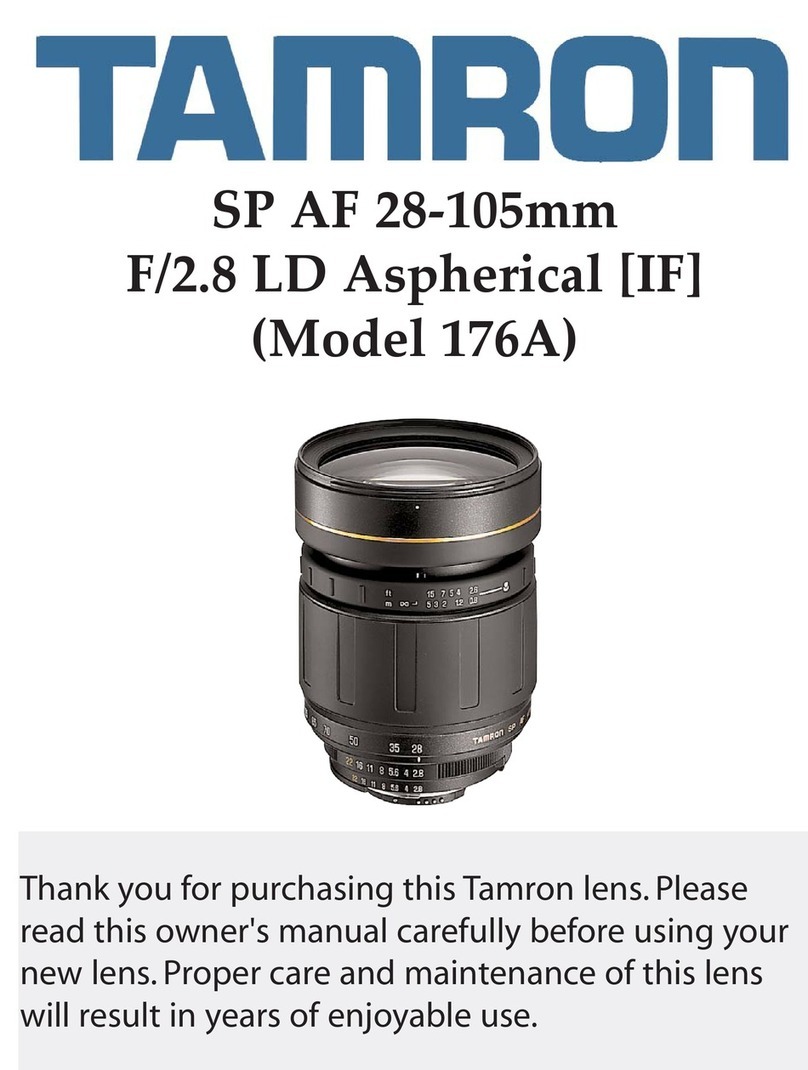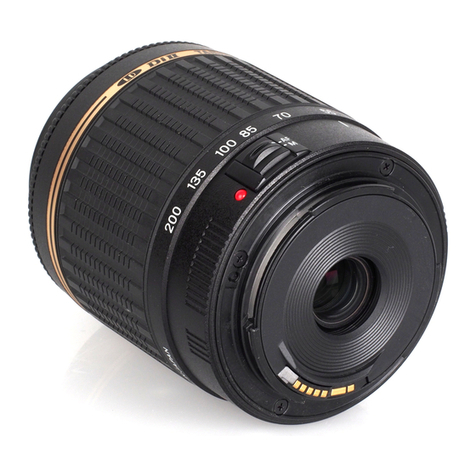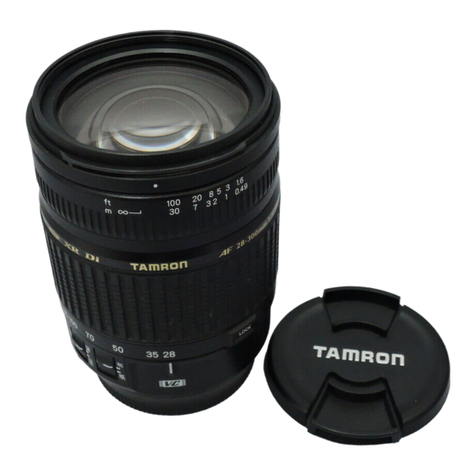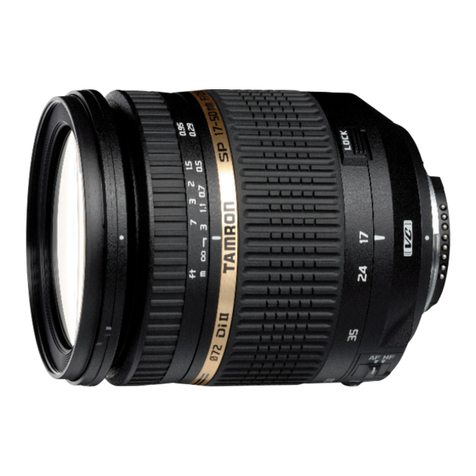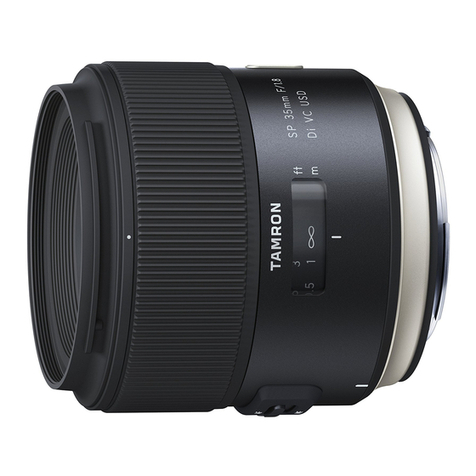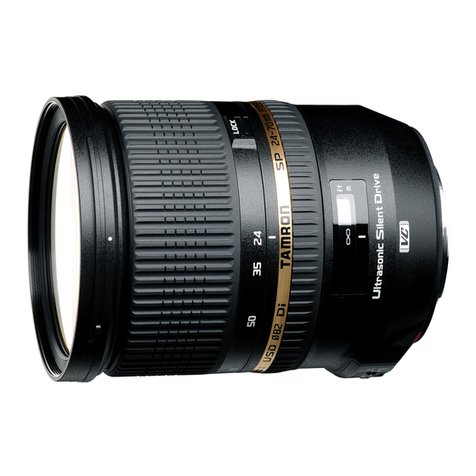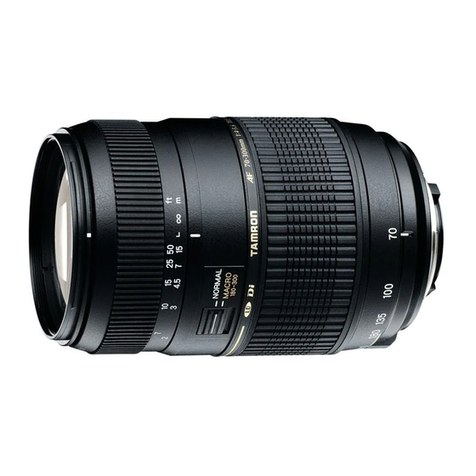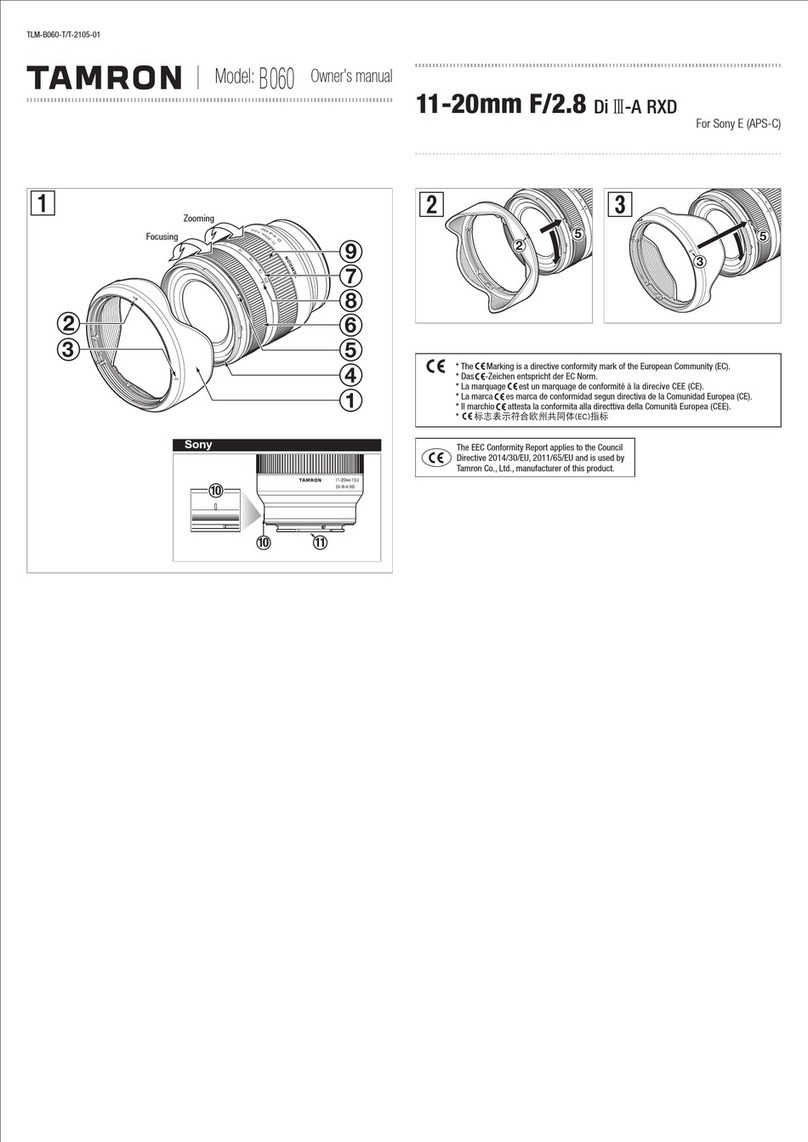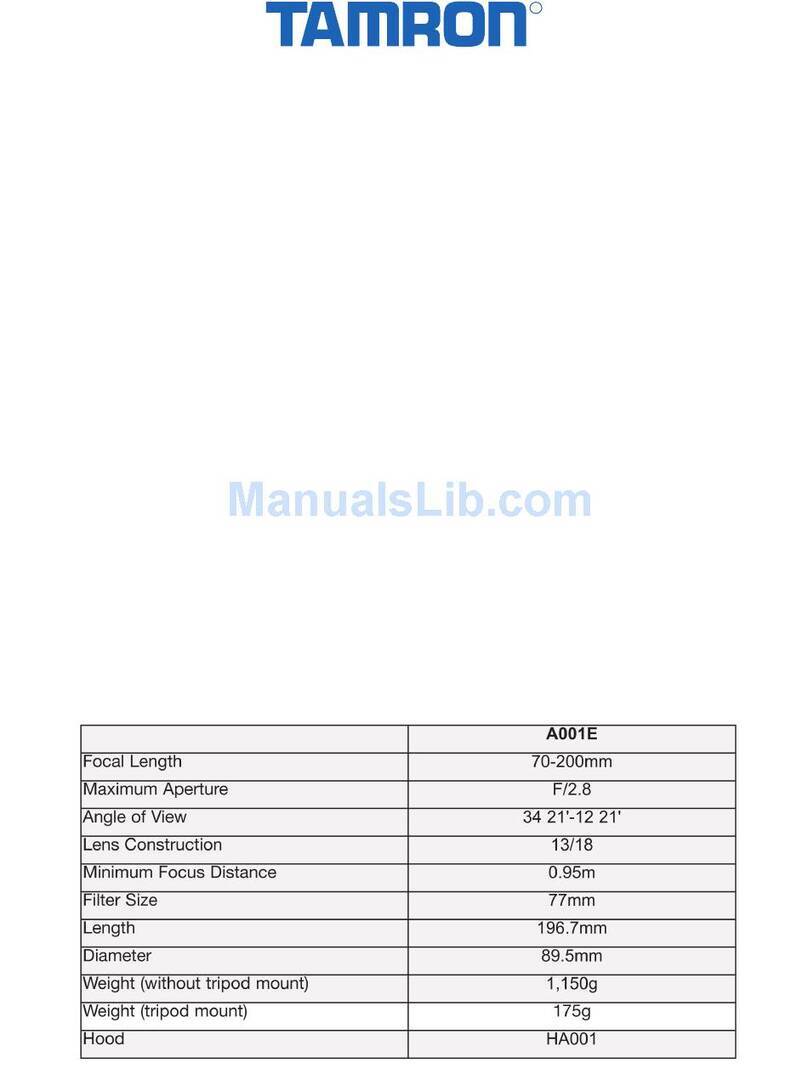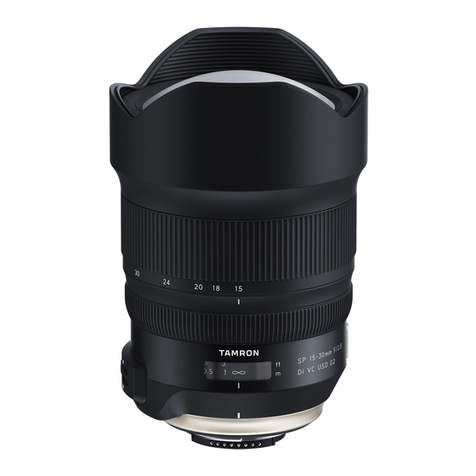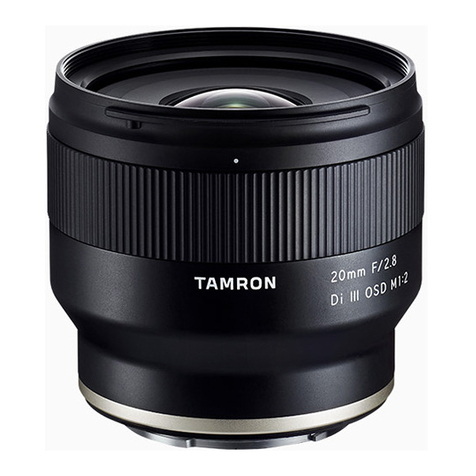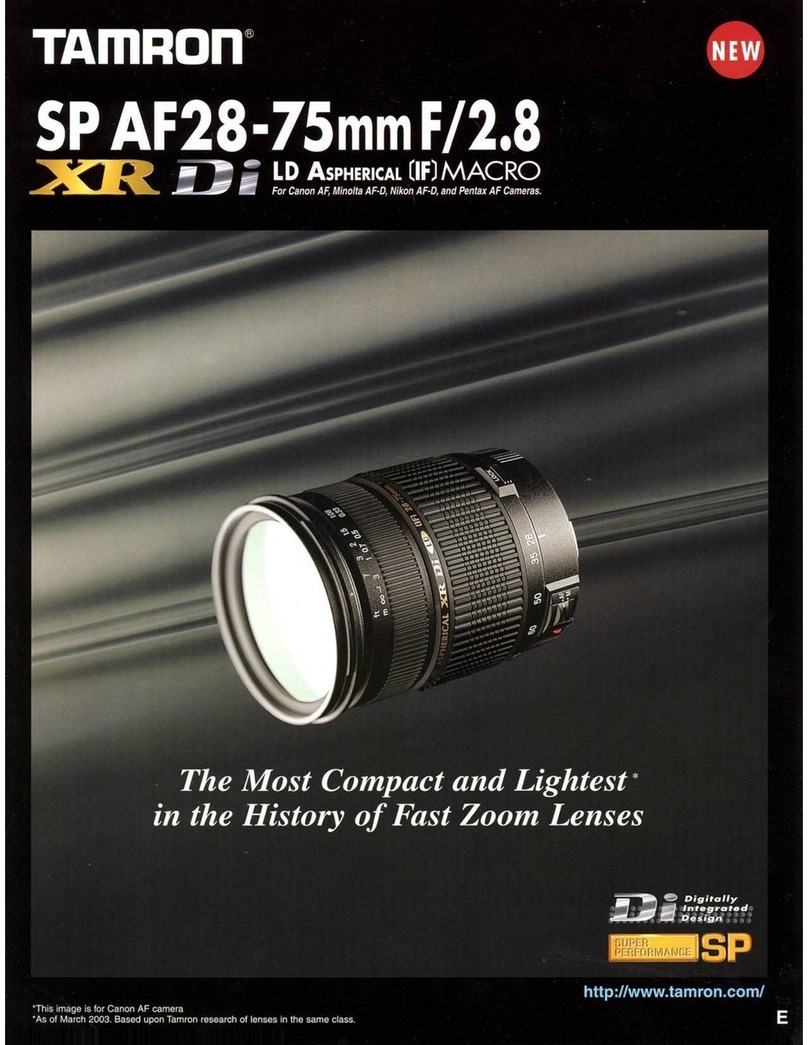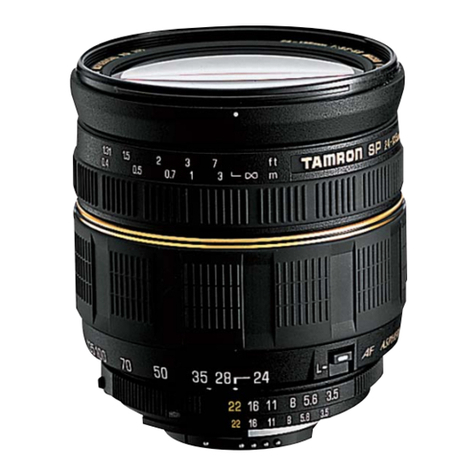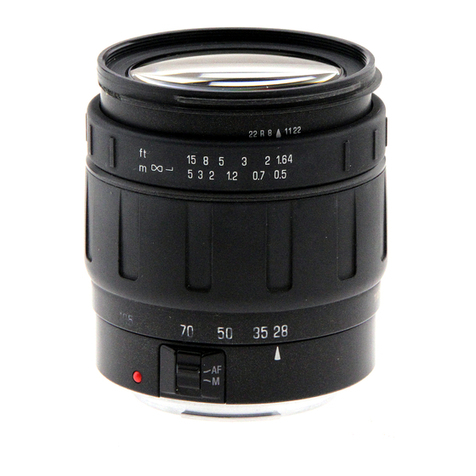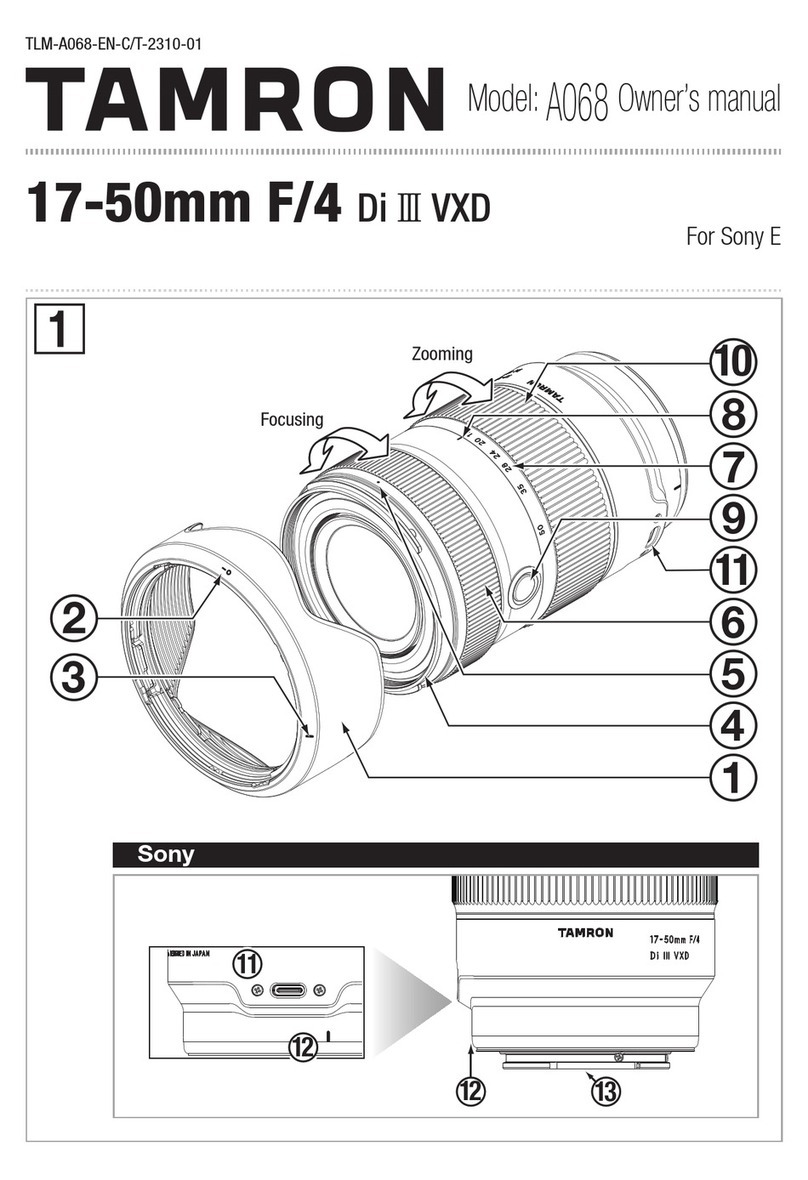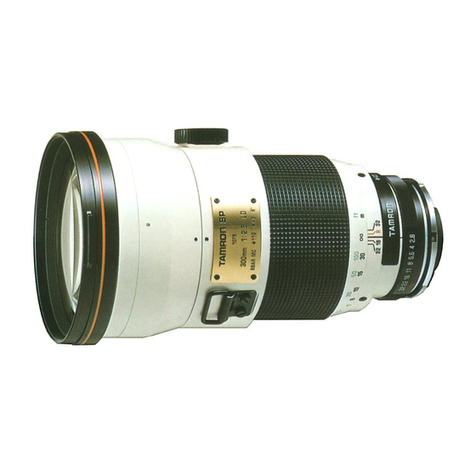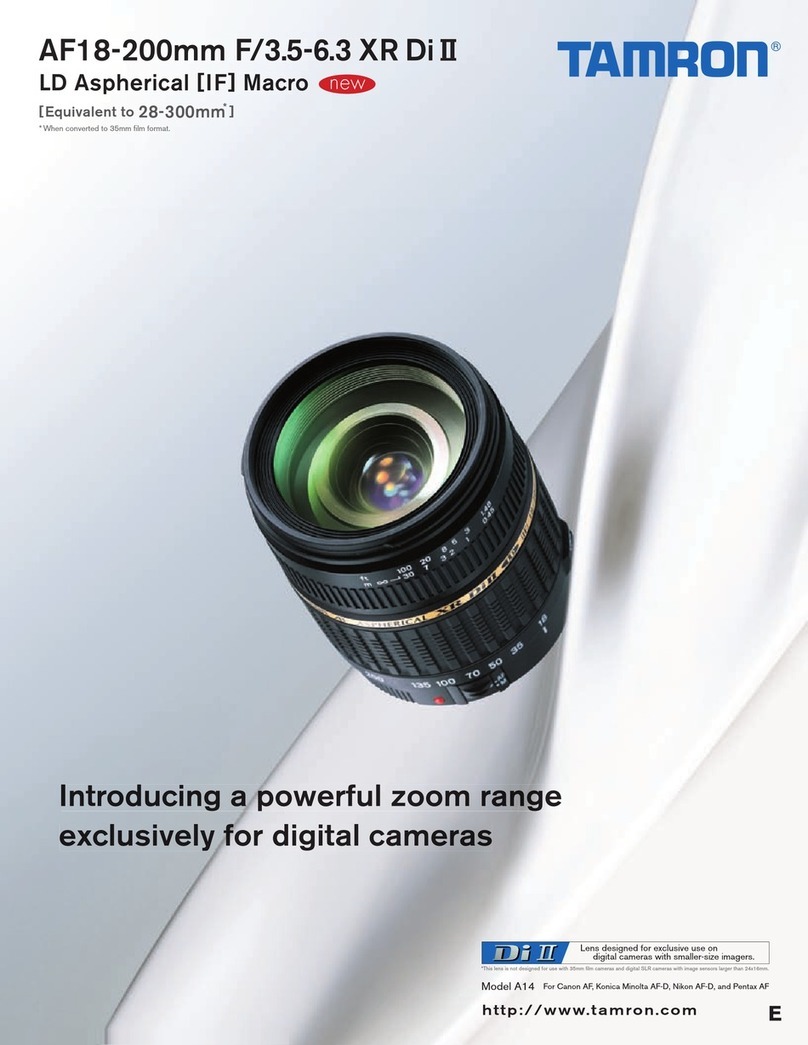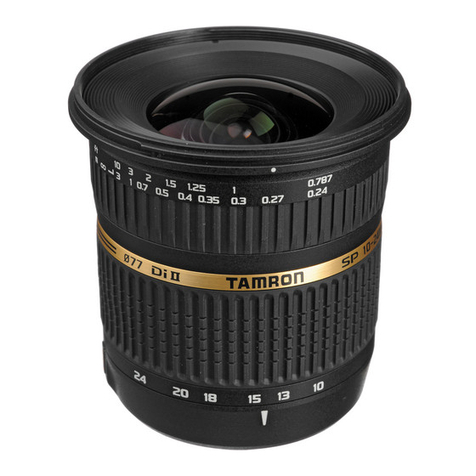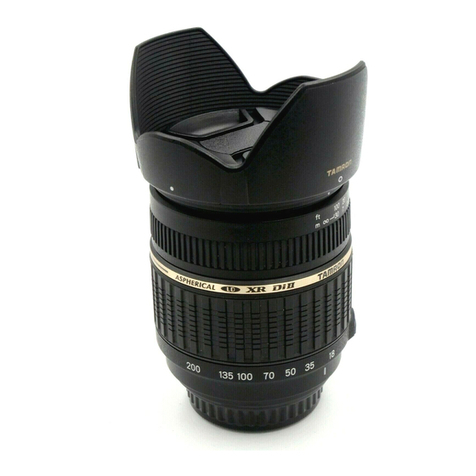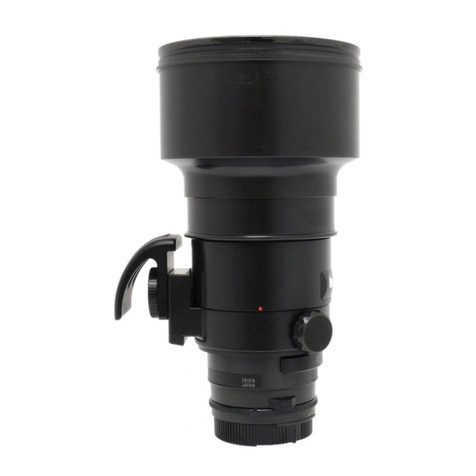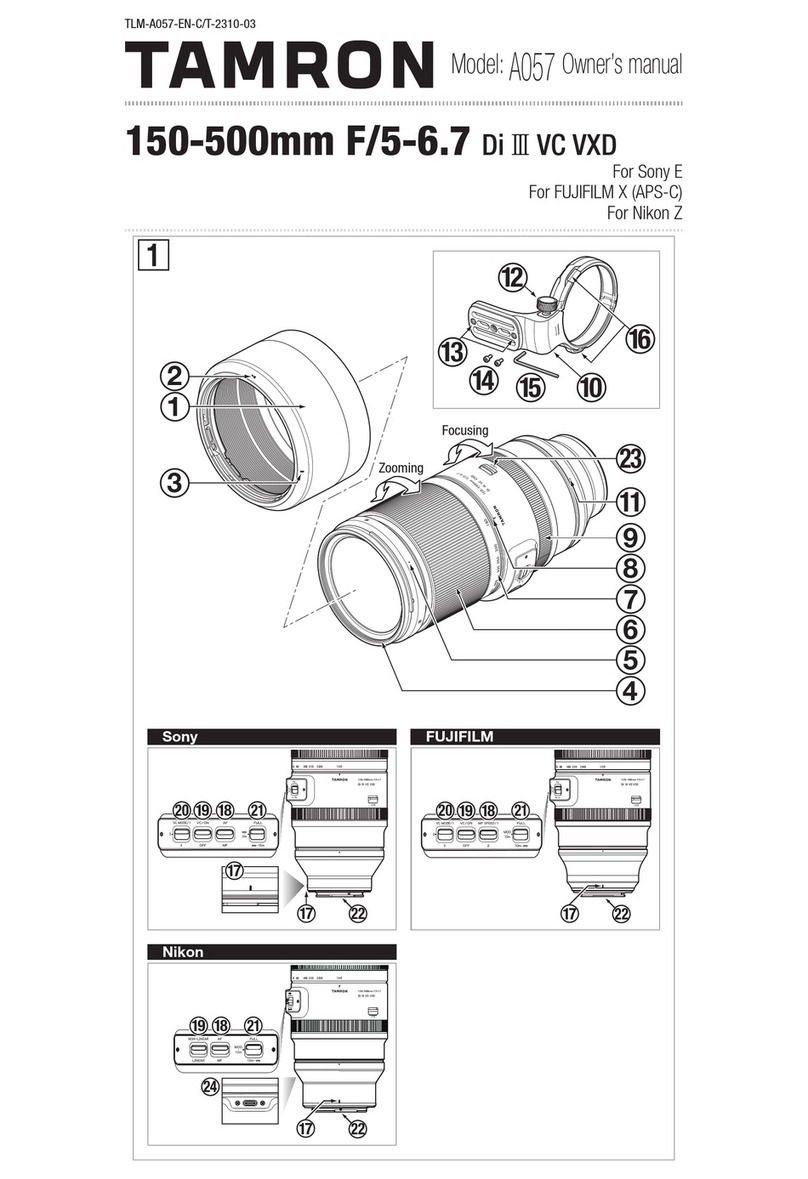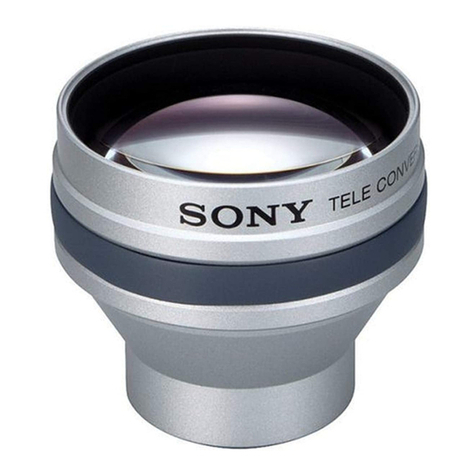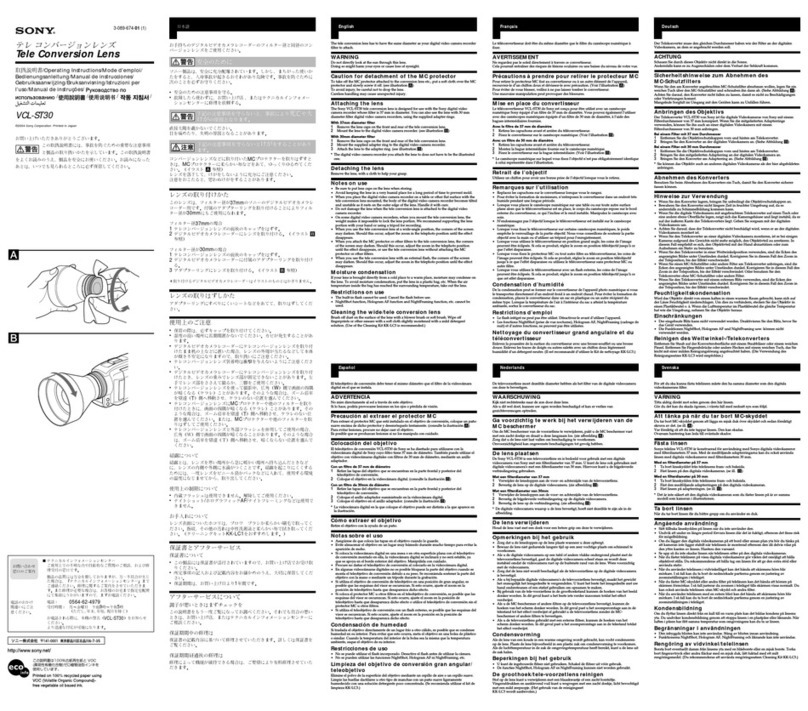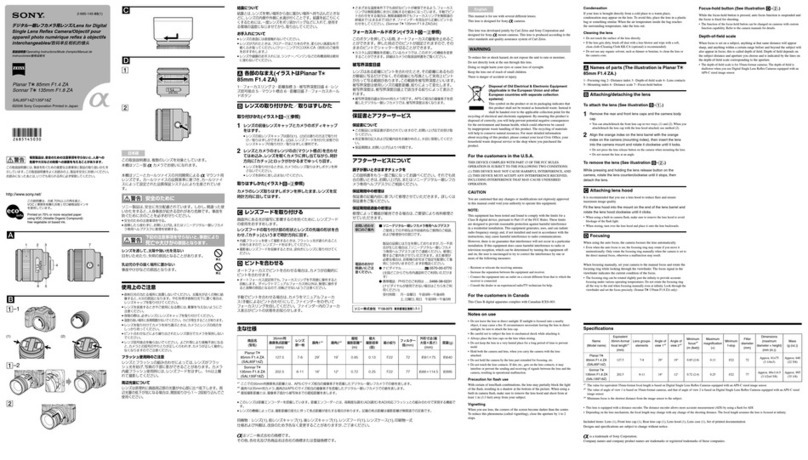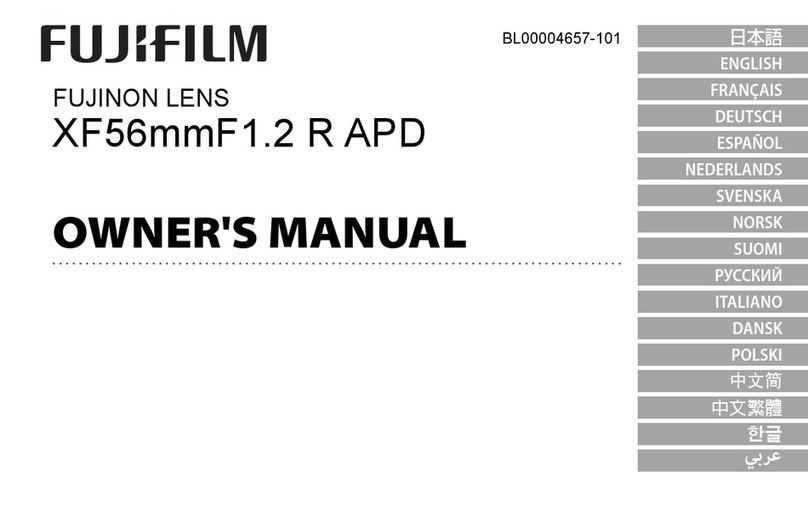
Thank you for purchasing the Tamron lens as the latest addition to your photographic
equipment. Di II lens (Digitally Integrated) series are designed for digital SLR cameras
with image sensors equivalent to APS-C size. Before using your new lens, please read
the contents of this Owner’s Manual thoroughly to familiarize yourself with your lens
and the proper techniques for creating the highest quality images possible.With proper
handling and care, your Tamron lens will give you many years of photographing
beautiful and exciting pictures.
폷Explains precautions that help to prevent problems.
폷Explains things you should know in addition to basic operations.
1Lens hood
2Hood attaching alignment mark
3Hood fixing alignment mark
4Filter attaching ring
5Hood attaching and removing alignment mark
6Focusing ring
7Length/Macro magnification scale
8Length/Macro magnification scale alignment mark
9AF-MF altering switch
0Lens attachment mark
-Signal contact
G005
Focal Length 60 mm
Maximum Aperture F/2
Angle of View 26°35
'
Lens Construction 10/14
Minimum Focusing Distance 0.23 m (9.1
'
)
Maximum magnification ratio of shooting 1:1
Filter Size ø55 mm
Length 80 mm (3.15
''
)
Diameter ø73 mm (2.9
''
)
Weight 400 g (14.1 oz)
Lens Hood HG005
폷Lengths and weights listed in lens specifications are for lens with Nikon mount.
폷Features and cosmetic designs of lenses listed in this owner’s manual may be revised
without notice.
쐽How to mount the lens
Removing the rear cap of the lens. Align the lens attachment mark (0) on the lens
barrel with its counterpart on the camera mount and insert the lens.
Rotate the lens clockwise (in case of Nikon lens, counter-clockwise) until it click-
locks.
쐽How to detach the lens
Pressing the lens release button on the camera down, turn the lens counter-clockwise
(in case of Nikon lens, clockwise), and lift the lens off the camera’s lens mount.
폷The image circles of Di II lenses are designed to match the digital SLR cameras using
the image sensors equivalent to APS-C (approx. 15.5 x 23.2mm). Do not use Di II lenses
with cameras using image sensors larger than APS-C. Using Di II lenses with such
cameras may cause vignetting on the image.
폷Some Canon cameras have index marks for attaching both EF lenses (red circle) and
EF-S lenses (white square).
To attach or remove the DiII lenses, align the lens attachment mark on the lens (0)
with the index mark for EF lenses.
Do not forcibly align the lens attachment mark with the index mark for EF-S lens
(white square) .
Doing so could result in damage to the lens and/or camera.
폷For further details, please read the instruction manual of your camera.
In case of Sony cameras, switch the focusing mode switch of the camera to Auto
focusing mode (AF). In case of a Nikon or Canon camera, switch the AF/MF switch (9)
on the lens to AF. (Fig. 3). In case of Nikon camera with the focus mode selector dial,
set the focus mode to “S” or “C”, and then set the AF/MF switch on the lens side (9) to
“AF”. Press the shutter button lightly while viewing through the camera’s viewfinder, the
lens focuses automatically. An in-focus mark will light when lens focuses on the main
subject sharply. Press the shutter button further to photograph.
Using the full-time manual function?
G005 is equipped with the full-time manual function.
The full-time manual function is a function that the focus can be fine-tuned by the
manual focus without switching the AF/MF changing switch when taking a picture of
auto focus.
폷How to use the full-time manual function
First, set the focus mode to “AF”.
You can adjust focus manually while turning the focus ring in the shutter button is
pressed lightly.
폷When set on AF mode, interfering with focusing ring (6) may cause serious damage to
the lens mechanism.
폷
The distance scale (7) is marked for guidance purposes. The actual focal point may
slightly differ from the distance marked on the focal length index.
폷For further details, please read the instruction manual of your camera.
In case of Sony cameras, switch the focusing mode switch of the camera to manual
focusing mode (MF). In case of a Nikon or Canon camera, switch the AF/MF switch (9)
on the lens to MF. (Fig. 4) In case of Nikon camera with the focus mode selector dial,
set the focus mode to “M”, and then set the AF/MF switch on the lens side (9) to
"MF". Focus manually rotating the focusing ring (6) while viewing through the
camera’s viewfinder. The main subject in the viewfinder will be sharp when the lens is
focused correctly.
폷
Even in the MF mode, turning focusing ring (6) while pressing the shutter button halfway the
focus aid function lamp lights up when the picture is in focus.
폷At infinity, make sure the image in the viewfinder appears sharp. The infinity position on
G005 is made with certain allowances to insure proper focus under a variety of conditions.
폷For further details, please read the instruction manual of your camera.
Please follow the instruction manual of your camera.
A bayonet-type lens hood is provided as standard equipment. We recommend shooting
with the hood attached whenever possible as the lens hood eliminates stray light which
is harmful to the picture. However, please be aware of the "PRECAUTIONS IN
SHOOTING" when your camera is equipped with a built-in flash.
쐽Attaching the Lens Hood (Ref. Figs. 5& 6)
Align the hood attaching alignment mark (2) on the hood with the corresponding hood
attaching bayonet ring (5) (or the top of the index line of the distance scale) on the
lens. Press the hood lightly onto the hood attaching bayonet ring (Fig. 5) and then
rotate it clockwise to secure (Fig. 5). The lens hood will be securely held as the mark
“TAMRON 쑗” comes to the top (Fig. 6).
폷
Pay particular attention to align the hood attaching indexes when using zoom lenses
including wide-angle (e.i. 35 mm or wider) settings.
Improper attachment of a hood for wide-angle zoom lens may cause large shadowed
areas in your pictures.
쐽Removing the lens hood
1) Turn the hood 1anticlockwise. The lens hood 1will be removed from the lens.
쐽Stowing lens hood on the lens
1) Point the lens hood toward to opening, then align the hood attachment mark 5
on the lens with the (TAMRON 쑗) alignment on the hood 3(Fig. 7)
2) Turn the hood 1 anticlockwise until its alignment mark 2 is at the top to set it (Fig.
7).
쐽Removing the lens hood when stowing
1) Turn the hood 1anticlockwise. The lens hood 1will be removed from the lens.
폷The optical design for Di II takes into consideration the various features of digital
single reflex cameras. However, due to the configuration of the digital single reflex
cameras, even when the autofocus accuracy is within specifications, the focal point
may be a little forward or behind the optimum point when shooting with auto focus
under some conditions.
폷The image circles of Di II lenses are designed to match the digital SLR cameras using
the image sensors equivalent to APS-C (approx. 15.5҂23.2mm). Do not use Di II
lenses with cameras using image sensors larger than APS-C. Using Di II lenses with
such cameras may cause vignetting on the image.
폷(G005) employ an internal focusing (IF) system. Because of the characteristics of this
optical design, the angles of view at distances other than infinity are wider than that
of the lenses applying an ordinary focusing system.
폷When the built-in flash on the camera is used, adverse photographic phenomena such
as corner illumination fall-off or vignetting at the bottom part of the image may be
observed, especially in wide angle ranges. This is due to the inherent limitation of the
coverage of the built-in flash,and/or the relative position of the flash to the edge of
the lens barrel which causes shadows on the image. It is strongly recommended to
use a suitable separate flash unit provided by the camera manufacturer for all flash
photography.
For further details, please read the “built-in flash” article on the instruction manual of
your camera.
폷The use of teleconverters is not recommended due to the optical performance of the
lens.
폷When using the lens in the telephoto focal range, please be careful with the camera
shake. Effective way to avoid the camera shake is using an ISO setting of higher
numbers. Using a tripod or monopod is also effective.
폷When set on AF mode, interfering with focusing ring may cause serious damage to the
lens mechanism.
폷Certain camera models may indicate the maximum and minimum aperture values of
the lens appropriate numbers. This is not an indication of an error.
폷Avoid touching the glass element surface. Use a photographic lens cloth or blower to
remove dust from the lens element surface. When not using the lens, always place a
lens cap on it for protection.
폷Use a lens cleaning tissue or lint cloth with a drop of cleaning solution to remove
fingerprints or dirt on the glass lens surface with a rotary motion from the center to
the edge.
폷Use a silicon cloth to clean your lens barrel only.
폷Mildew is an enemy of your lens. Clean the lens after shooting near water or in any
humid place. Store your lens in a clean, cool and dry place.When storing the lens in
an lens case, store it with commercially available drying agent such as silica gel, and
change the agent occasionally. If you find mildew on your lens, consult an authorized
repair shop or nearby photo-graphic store.
폷Do not touch the lens-camera interface contacts since dust, dirt and/or stains may
cause a contact failure between the lens and camera.
폷When using your equipment [camera(s) and lens(es)] in an environment where the
temperature changes from one extreme to the other, make sure to put your
equipment temporarily in a case or a plastic bag for a length of time in order for the
equipment to go through a gradual temperature shift.
This will reduce potential equipment trouble.
ENGLISH
NOMENCLATURE (Refer to Fig. 1, if not specified)
SPECIFICATIONS
ATTACHING AND REMOVING THE LENS (Ref. Figs. 1)
FOCUSING (Autofocus) and using the full-time manual function
FOCUSING (Manual Focus) (Ref. Figs. 1, 2& 4)
PRECAUTIONS IN SHOOTING
TO ENSURE LONG-TERM SATISFACTION
LENS APERTURE AND AE MODE
LENS HOOD (Ref. Figs. 1, 5, 6& 7)
